Literature nerds and history dorks have superheroes, too: Edgar Allan Poe, William Shakespeare, Mark Twain, Anne Rice, Lucy Maud Montgomery, Laura Ingalls Wilder, Ken Burns, The Brontë Sisters, Thomas Jefferson, David McCullough, Miss Savannah Squirrel (of course!) and a whole league of historians and novelists. The standout heroine for the geek girly-girl strain of this genre? Miss Jane Austen, indeed!
As one of this strain, not to mention a long-time member in good standing of the comic genre, I can affirmatively state Miss Austen is our Wonder Woman, Superman, Batman and Scully all wrapped beautifully under a tidy, feathered, grosgrain-trimmed, Regency bonnet. (Yes, Scully is not only a comic book heroine but also has her own action figure; I own both.) Wherein this modern age, sometimes, some feel like a fish out of water, Miss Austen gives us everything we need to cope: literature, vocabulary, historical detail, rigid manners, meticulous décor and blissfully asyndetic conversation. Austen is the It Girl of Britain's Regency era and, where softer, quieter geeks are concerned, she and her characters are models of grace, gentility and marmoreal skin in what is a surely a more tarnished, gauche, crude and frumpy world. Jane's superpower? A soft voice and an extensive vocabulary. One must lean in close to hear her pithy, social banter. You must lean into her; therein lies the power. Where there is power, there is also the threat of downfall. Her silver bullets and Kryptonite? 140 characters and scatalogical humour.
If Austen and her characters (Elizabeth Bennet, Emma Woodhouse, Catherine Morland, Mr. Darcy) form a high society of superheroes, Snooki and her double-digit IQ, vulgar ilk are their nemeses. With the whip of a bonnet sash, a quick flick of an embroidered, Irish handbag and the lightning-fast scribe of a handwritten thank you note, Miss Jane and her Society could rid the culture of Jersey June bugs, Real Housewives, Kardashians and Hooters. Taste always trumps tacky.
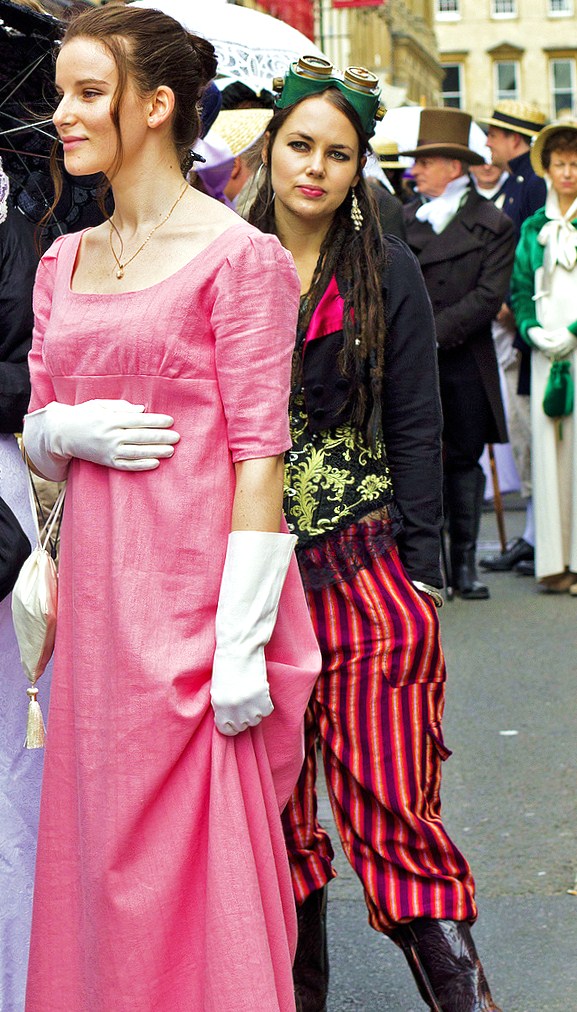 If being a bit of a prude is not quite a punishable crime today, it is unquestionably dorky and out of vogue. Jane Austen assuages the modern prude with emergency rations of taste, etiquette and elegance when necessary. She gives us pale, graceful necks sans tan lines, delicate drop earrings, amusing chapeaux, bone china and witty repartee. Jane gives us Gwyneth Paltrow, Kate Winslet and Keira Knightley sipping English breakfast tea and shading their pearlescent bosoms from the harsh, Yorkshire sun with the prettiest of Battenberg lace parasols. It is like The Real Housewives of Atlanta and Honey Boo Boo never slithered under the garage door and into our house.
If being a bit of a prude is not quite a punishable crime today, it is unquestionably dorky and out of vogue. Jane Austen assuages the modern prude with emergency rations of taste, etiquette and elegance when necessary. She gives us pale, graceful necks sans tan lines, delicate drop earrings, amusing chapeaux, bone china and witty repartee. Jane gives us Gwyneth Paltrow, Kate Winslet and Keira Knightley sipping English breakfast tea and shading their pearlescent bosoms from the harsh, Yorkshire sun with the prettiest of Battenberg lace parasols. It is like The Real Housewives of Atlanta and Honey Boo Boo never slithered under the garage door and into our house.
Jane leaves her admirers gleefully free of red Solo cups, texting, Twitter, fast food, zombies (with the exception of Pride and Prejudice and Zombies by Seth Grahame-Smith), Facebook, reality TV, Vegas, cell phones, Pandora, 24-hour news, TMZ, gaming, CGI, toe rings, Pirates of the Caribbean V, sailor language, Breaking Bad and stupidly oversized iPads held aloft to Tweet pictures taken at the seashore. To be sure, I enjoy some of the above, minus Facebook, zombies and fast food. Whilst I do have a strong prudish streak, I am not a true prude. In fact, I may be the only one to defend Miley Cyrus' plushie sex twerking at the VMAs and, if you've read my latest novel, The Darlings of Orange County, you know full well I have a twerky side. Still, like spiced rum, Nutter Butters and plushie twerking, everything has its time, place and limits. They do not compose healthy, daily sustenance. Where there is overload, there is overkill and often not enough mouthwash in the world. Is not Miss Austen a lovely diversion, an occasional antiseptic, if you will?
Jane's world can be a balm, but it can also be a gilded trap: Austenland. Thus, the case for Jane Hayes, a thirty-something Austen addict played convincingly by freshly-scrubbed, natural beauty Keri Russell (Felicity, Running Wilde, Wonder Woman). Austenland is a scrumptious, directorial debut for Jerusha Hess (Napoleon Dynamite) and a brilliantly cheery romantic-comedy based on the novel of the same name by authoress Shannon Hale (Rapunzel's Revenge, Princess Academy).
If audience engagement is any marker, Austenland is running for the roses. Like New Orleans, Disneyland or the Nordstrom Anniversary Sale, if you are not having a great time, you might be a zombie. Replete with, yes, mostly older women en seul, most everyone guffawed, tittered, giggled and ahhhed throughout all posh ninety-seven minutes. The few men I did see had the relaxed look that comes with watching a non-taxing film in comfy, recliner theater seats with their feet up and their Birkenstocks left on the floor. (Decidedly very non-Austen.) To be sure, the men I did see were also accompanied by their ladies. My own Mr. Darcy knew we had to see Austenland after viewing the trailer at a recent showing of Blue Jasmine. "Well, we have to!" he insisted with a chuckle. "That is so you!"
Spot on, in fact! From Jane Hayes' flashbacks, taking her own tea cup and saucer to a cafe, to her life-sized, cardboard cutout of Mr. Darcy (mine was Johnny Depp), to theme dressing at the airport, Austenland has happy, quiet, dork handwritten all over it.
The casting is polished to perfection: not a bruised apple in the barrel. Jennifer Coolidge (Best in Show, Legally Blonde, 2 Broke Girls) steals the show. Her tacky-but-sweet American with cash is sheer precision. An oversized Barbie in Regency hot-pink, her character of Miss Elizabeth Charming is an absolute hoot. 'Er 'orrible, overdone, Eliza Doolittle accent is as amusing as her hats (which I actually covet) and her enthusiasm for the total-immersion English holiday is contagious, making me very pleased with myself that I wore a Regency-inspired, empire-waist, Japanese mini-dress and pewter drop earrings for the occasion.
Lady Amelia Heartwright, played fetchingly by Georgia King, is a fellow Austenland traveller, filling out the triad of ladies on literary holiday. She is a whimsical, living doll reminiscent of silent-era actresses known as much for their pouty lips, porcelain skin and large eyes as their comedic timing and X-CU expressions. Hopping hither and thither like an exquisite, mischievous rabbit, King keeps the laughter cavorting across the vast estate lawns. Keri Russell plays the lead role as Jane Hayes/Miss Jane Erstwhile with a delicate realism any Austen dork knows all too well: social awkwardness, happy oblivion and a nearly overbearing obsessiveness that only the best of friends and spouses will ever understand or tolerate.
In Austenland, run with the icy business head of Mrs. Wattlesbrook, played deftly by Jane Seymour, the men serve as either eye candy or hired soul mates. Ironically, it takes a dose of holiday fiction for Miss Erstwhile to realize that her blanket assessment, "apparently the only good men are fictional", is wrong ... or is it? For it is in Austenland where Jane finds her Mr. Darcy ... or is it? Maybe it is only once she is free of the Austen spell ... or does the Austen spell indeed prove the very magic she needs? A torrential English rain, a soaked, lovely damsel-in-distress, an impossibly handsome Mr. Henry Nobley (played by the utterly smoldering JJ Feild, known to some as the tragically-fated, beautiful gentleman-officer, Major John André of AMC's TURN: Washington's Spies) on a grey horse and a linen dress ripped by said-Mr. Nobley, exposing a bit of fine, Regency leg, certainly never hurts the start of a romance.
I haven't clapped aloud in a theater in quite a while. Many moons ago, I did so at the end of Pirates of the Caribbean: The Curse of the Black Pearl, the first of the POTC franchise. Similar to POTCI, Austenland not only provides fun storylines and sympathetic characters, but enough visual stimuli to ensure at least a second viewing: costuming, set design, colours, location, landscape, architectural detail and all the fine points one would only notice when they are omitted. Emerging from POTC I in 2003, my own Mr. Darcy excitedly said, "Now that is what going to the movies should be like! Wow! That was awesome!" He said the same thing as we emerged from Austenland last week. "Maybe it's because I know you and Lesli so well," referring to my fellow historical-dorkette, "but that was hilarious!"
True, perchance because he could see my cohort and me in so many situations, he laughed as hard as most of the women in the theater, their laughter also betraying intimate understanding. By the laws of comedy, good writing and production values though, this film is just Plain Jane good stuff for anyone! Certainly, as comedy is relative, knowing the characters adds another layer of humour. I do know these people; it does add another layer.
Many will roll their eyes. "Sounds more superficial than superhero. Where's the superheroine in all this twaddle? What is so powerful about being prudish, posh and persnickety?" The power lies not in the aesthetics of Austenland or any other pretty mis-en-scène; the power lies in the cheerful confidence it takes bring bits of this old-fashioned life, including the quickly disappearing art of social conversation, to our modern one. The power lies in being true to one's inclinations, no matter how unpopular. Take a look around, desperately casual, blasé and mouthy is all the rage; quiet, modest and polished is not. Being a geek girl, I am told ad nauseam, means not taking guff from anyone. As far as I can see, ass-kicking can come via Knives Chao, Power Girl and Lara Croft as easily as it can via Elizabeth Bennet, Laura Ingalls and Anne Shirley.
Power can carry a parasol through a gauntlet of terrifying, sniggering, beach teens; power can use far too many words to share a simple link; power can spend years writing about a colonial squirrel, knowing most will only laugh about it while a mere handful will read the tales; and, power can take an hour to sip her tequila shot like it is a Royal Doulton cup of Darjeeling, despite friendly taunts and peer pressure to chug. Some of us do not chug, ever.
Being true to oneself is today's real superpower. If only I had a pearl drop earring for every time someone asked me with a poorly hidden smirk, "Why are you so dressed up?", "You're not seriously wearing that?" or "I can't deal with your emails. Too many big words.", well, I would have even more pearl drop earrings than I already do. Geeks come in all shapes and sizes. If your shade of pale is lavender-hued, you use a soft voice, too many big words and carry an analog copy of Pride and Prejudice, own it.
Psst ... when you see Austenland, stay put for the end-credits. It all gets a little hot in here!
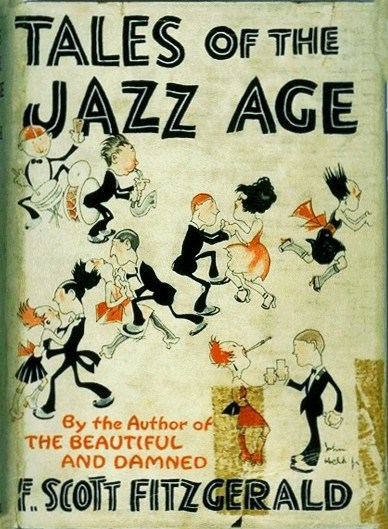 If one film has recently pinged my annoyingly particular radar screen with a single sparkly note, it is The Great Gatsby. Thrilled at the prospect of a big-budget feature finally dedicated to the art of storytelling, eschewing the long-overdone, over-hyped, cheesy SFX genre, I instantly started swinging my vintage Whiting & Davis handbag round my wrist in anticipation. Just as my tootsies started to join in the fun, my Mary Janes ready to Charleston, I learned Baz Luhrmann's The Great Gatsby of 2013 is in 3-D. Zowie!
If one film has recently pinged my annoyingly particular radar screen with a single sparkly note, it is The Great Gatsby. Thrilled at the prospect of a big-budget feature finally dedicated to the art of storytelling, eschewing the long-overdone, over-hyped, cheesy SFX genre, I instantly started swinging my vintage Whiting & Davis handbag round my wrist in anticipation. Just as my tootsies started to join in the fun, my Mary Janes ready to Charleston, I learned Baz Luhrmann's The Great Gatsby of 2013 is in 3-D. Zowie!
Be clear, yours truly is no Luddite. I adore and applaud progress, when necessary. If you've read my novels and regularly read my geek-culture articles and blog posts, you shall well know I embrace the Zeitgeist. Love me some Zeitgeist! Still, F. Scott Fitzgerald's literary masterpiece of self-doubt, jealousy, betrayal, murder, manipulation and heartbreak has zero need for 3-D confetti.
Still, how could a jazzy sweet patootie such as myself pass up this sumptuous, vicarious, visual fête of champagne, glitter, diamonds, feathers and fishnets? Surely the story remains in tact; certainly no main chacarters have been sidelined or their magnanimity diminished. So, I agreed to plop down my cabbage and see it, despite the threat of such aggressive progress ... then, I read Rex Reed's brutal and scorching review. Though I am not generally given to paying much mind to film reviews, Reed's warning left me aghast and faint-hearted, stunned by a gilded sense of foreboding. Reed proffers a glimpse into a film so ruthlessly bad that, were I to see it I might turn to stone, like a victim of Medusa, my face frozen in perpetual horror as a Duesenberg hood ornament flies at my powdered face. I had to rethink my decision to shell out said-cabbage. Then, happily, along came new information about the costume design.
The 1920s marked an age as pivotal and dynamic as our own technological age. America was shifting from an agricultural existence to an industrial one as feverishly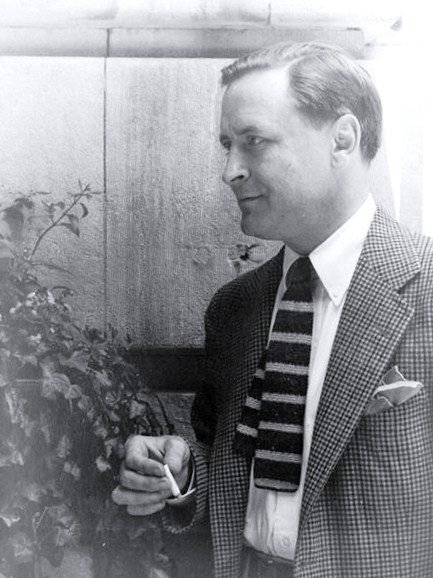 and unabashedly as a drunken, desperate, last-hurrah, Labor Day dock party in the Hamptons. Single girls were moving from family farms to the big cities in droves, ready to pop their champagne corks and break free from the wasp-waist whalebone corsets and high-neck lace blousons of their Victorian and Edwardian grandmamas. No more milking the cows and darning Pa's socks. The Jazz Age was nigh and it was America's well-earned, Naughty Weekend: sex, jazz and, despite a decade-plus of Prohibition, booze. (Step off, 1960s. You old hippies never even came close.) It was as though we knew the Thirties were coming with it's Great Depression, Dust Bowl, dowdy Red Cross shoes and the distant knell of WWII. It was time to party and party hard. So, ask any twenty-something, what's the best way to party harder than your grandparents ever did, annoy your elders and distance yourself from your parents? Attitude, excessive booze and, of course, style.
and unabashedly as a drunken, desperate, last-hurrah, Labor Day dock party in the Hamptons. Single girls were moving from family farms to the big cities in droves, ready to pop their champagne corks and break free from the wasp-waist whalebone corsets and high-neck lace blousons of their Victorian and Edwardian grandmamas. No more milking the cows and darning Pa's socks. The Jazz Age was nigh and it was America's well-earned, Naughty Weekend: sex, jazz and, despite a decade-plus of Prohibition, booze. (Step off, 1960s. You old hippies never even came close.) It was as though we knew the Thirties were coming with it's Great Depression, Dust Bowl, dowdy Red Cross shoes and the distant knell of WWII. It was time to party and party hard. So, ask any twenty-something, what's the best way to party harder than your grandparents ever did, annoy your elders and distance yourself from your parents? Attitude, excessive booze and, of course, style.
By the Roaring Twenties, gone were the tight-laced, buttoned-up, sartorial standards of the wet smacks whom came before this Jazz Age of rowdy pips. Enter stage left: swishy fringe, fouffy feathers, dyed furs, beaded minis, overflowing accessories, unstructured waists, mannish bobs and scandalous hemlines showing off all those great getaway sticks capped with shiny kitten heels, clearly not cobbled for dour farm girls and stay-at-home bankers' wives. Hit the road, Gibson Girl. Hello, Dolly! The middle class was climbing down from the hay lofts and with their new lives came a desire for kippy threads. Brooks Brothers, already a hundred-year old establishment, was there to answer the call, even if their price points have never been solidly middle-class.
If anyone knows Jazz Age dressing, it's our American Brooks Brothers. If anyone knows flash, soiree style, it's the Italian atelier of Prada. If anyone knows production design and costuming it's frequent Luhrmann collaborator, fellow Aussie and BAFTA- and Oscar-winner Catherine Martin (Moulin Rouge, Romeo + Juliet, Strictly Ballroom). When I learned these powerhouses of the posh and panache were responsible for Luhrmann's eye-candy, it was clear I needed to, as I said, rethink this spectacle.
In an instant, I knew Brooks Brothers was involved. When striped, regatta blazers, straw boaters and striped ties make the scene, it's clear they're involved. In fact, the nearly-200-year old haberdasher has been involved from the get-go, even outfitting The Great Gatsby author F. Scott Fitzgerald himself, ordering directly from their catalogs throughout the Twenties. His devotion to the outfitters helped make popular various styles, including their signature button-down, attached-collar shirt.
Founded in New York City in 1818, the same year the White House reopened after having been torched by the Brits during the War of 1812, and the same year the U.S. Congress decided our flag would have thirteen red and white stripes and twenty stars, Brooks Brothers is America's oldest clothing retailer and first ready-to-wear emporium. Spanning nearly the entirety of our country's existence, Brooks Brothers is no drifter when it comes to bespoke clothing for the upper-crust, making history, notoriously as well as famously.
President Abraham Lincoln, a loyal Brooks Brothers customer, was bestowed a special coat upon his second inauguration, the lining embroidered with an eagle and the inscription "One Country, One Destiny". (In fact, Brooks Brothers has outfitted thirty-nine of our forty-four U.S. presidents. George W. Bush might be one of the hold-outs, opting for J. Press as his outfitter, another Old School, upscale, but Yale-founded, New England-based clothier.) Eerily, Lincoln was shot at Ford's Theater wearing that same coat two tragic weeks later. Still, life goes on and along the way, Brooks Brothers quietly held history's hand.
Charles Lindbergh, unable to carry much luggage on his transatlantic flight, borrowed a coat upon his Paris landing, a Brooks Brothers belonging to the American ambassador. Clark Gable wed an aristocrat in B.B., his custom suit of choice, as no one else could fit his impressive physique of a 44" chest/32" waist. Legend has it pop artist Andy Warhol spent his first paycheck on a B.B. No. 10, white button-down. Perhaps, most impressive of all, Kermit the Frog owns at least one tiny, bespoke, amphibious tuxedo.
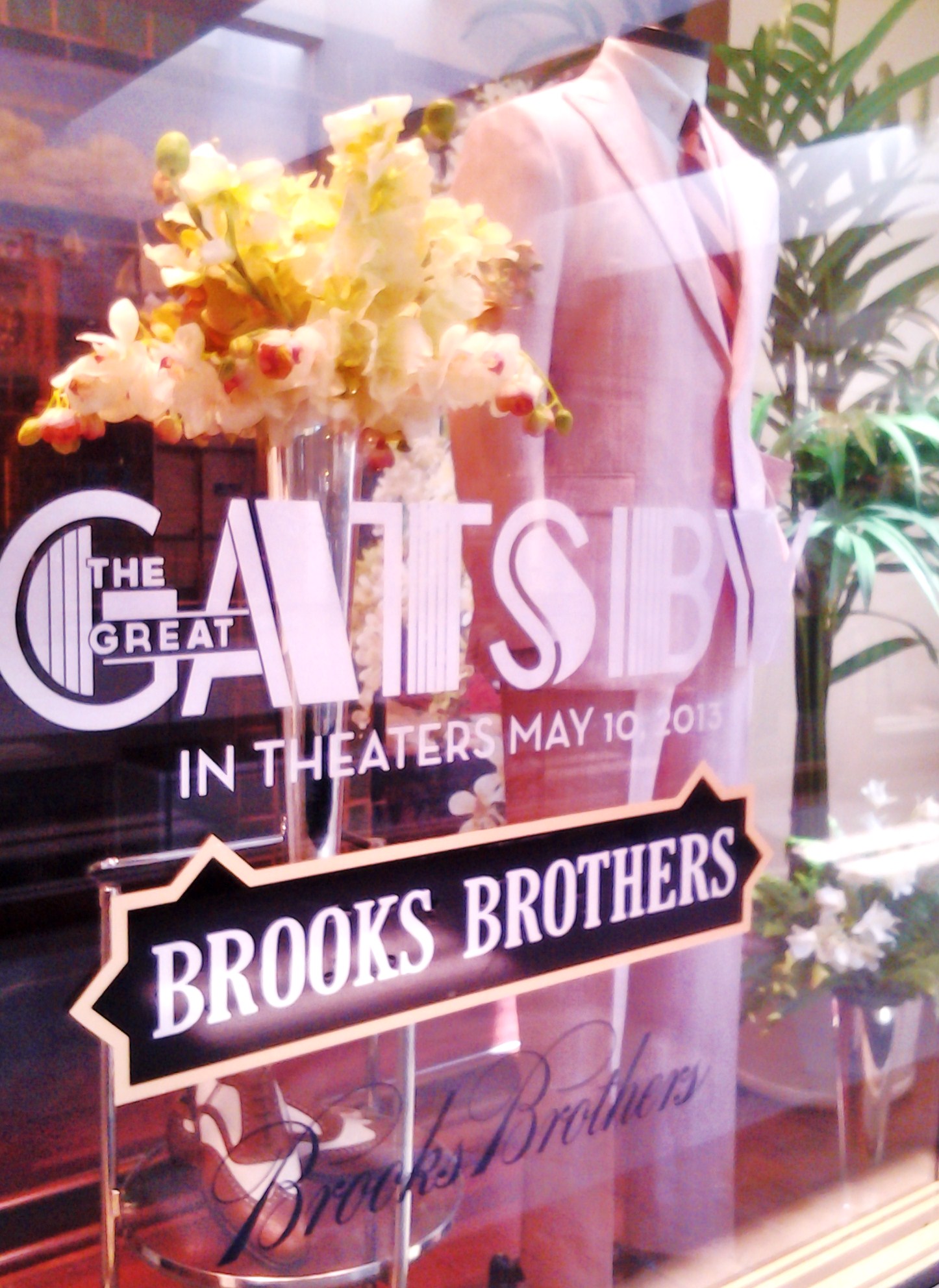 If you think Brooks Brothers is a bit blue-blood and starched-collar for this tacky and gauche film business, you are correct. Still, Brooks Brothers' vice-president of global relations, Arthur Wayne told Adweek, "We’re not a highly promotional brand. But, we do it when it feels right.” Considering Brooks Brothers was at the original party with Fitzgerald himself, one imagines it does feel right. Though they are also not usually known for film tie-ins, they are sporting a raw-ther nifty collection of summer togs for the lean of frame, beautiful of face and hearty of cabbage: Bright Young Things.
If you think Brooks Brothers is a bit blue-blood and starched-collar for this tacky and gauche film business, you are correct. Still, Brooks Brothers' vice-president of global relations, Arthur Wayne told Adweek, "We’re not a highly promotional brand. But, we do it when it feels right.” Considering Brooks Brothers was at the original party with Fitzgerald himself, one imagines it does feel right. Though they are also not usually known for film tie-ins, they are sporting a raw-ther nifty collection of summer togs for the lean of frame, beautiful of face and hearty of cabbage: Bright Young Things.
Where posh is concerned, Prada wrote the travel guide. Founded in 1913, Prada began its couture trek as a leather goods purveyor: steamer trunks, luggage, beauty cases, porte-monnaies, portmanteaux, handbags and a variety of luxury accessories. By 1919, just about the time Gatsby's sycophantic circle of friends were swinging from his chandeliers, Prada was appointed an official supplier to the Italian Royal Family.
As Egyptian travel became all the rage, thanks to Howard Carter, Lord Carnarvon and their 1922 discovery of Tutankhamun's tomb, Prada jewelry cases and resort bags saw action sailing up and down the Nile on Agatha Christie-style excursions. Queen Mary's polished decks were littered with Prada steamer trunks in the 1930s, many of those marked "P.O.S.H.": the abbreviation stamped on luggage belonging to passengers with top-flight rooms. What defines the best room on a cruise ship? The view, of course, sailing HMS Queen Mary in and out of Southampton and Dover: Port Outbound, Starboard Homebound, or P.O.S.H.
By 2012, four very posh gentleman donned their Jules Verneesque best as Prada reached back to Victoriana and embraced fashion's current obsession of steampunk. View Gary Oldman, Garrett Hedlund, Jamie Bell and Willem Dafoe in some very fetching, very attractive glad rags.
Before Brooks Brothers and Prada, the most recent posh designer to tackle the mighty task of Fitzgerald frippery was the legendary Ralph Lauren, dressing the ever-dapper, butter-and-egg man, Robert Redford in The Great Gatsby of 1974. Well done, Ralph. This time, Leonardo DiCaprio gets the swanky, onyx cufflink treatment, along with Tobey Maguire in shawl neck sweaters and deck shoes, looking a bit like he borrowed Father's cruise wear and unsure how to wear it. That could be the problem. One does not wear Brooks Brothers; one sports it. If one cannot, one should not.
According to more than a few critics, come awards-season, the special effects, acting and directing may just have to sit in the rumble seat of this Duesy. Brooks Brothers is driving Miss Daisy and Miuccia Prada is riding shotgun, with costume designer Catherine Martin sitting on her lap. This trifecta of fashion may be what pitches this pony over the finish line. To boot, whilst Jay-Z's hip-hop-infused Jazz Age soundtrack may be off-putting to purists, it seems a welcome addition to this dame. After all, modern-day hip-hop finds its roots in Twenties jazz and, considering the fashion may be the star of the show, one must have some high-kicking, free-swinging, jazz-hands tuneage to accompany those svelte Flappers and slick-haired Big Spenders, all togged to the bricks. As with many things in life, it really don't mean a thing if it ain't got that swing.
Yep, you shred it, Wheat. Looks like I just might have to hand over my cabbage to Mr. Luhrmann after all.

Hey, kids! It's me, Miss Hannah Hart, your friendly ghostdame of The Del. Just skipping about the Roku this morning in my luxe Resort Suite at the Hotel del Coronado this gorgeous summer’s day ... and what did I find? Disney is giving up the goods: Classic Mickey & Friends cartoons!
I watched each and every one of Walt’s mini-flickers when they originally came out in theaters as early as the 1920s. Even after my unfortunate demise in 1934, I hightailed my haunted self into theaters well up into the 1960s. (After that, theater-going became a little sketchy in the 1970s, especially in downtown San Diego, Boston and New York. Icky and sticky.) Trust me, being a ghost up through the 1960s was much easier than it is now (far less crowded); plus, folks dressed a might better when going to the pictures. (Remember heels and hairbrushes, dames?) Disney animated shorts just filled up the dark, like a gentle flood of colour accompanied by the lulling sound of happy fantasy and storytelling. There’s nothing like a Disney cartoon.
Why Change Your Wife? (1920) is a matrimony “comedy” by Cecil B. DeMille. There are two possible responses to a movie like Why Change Your Wife?: mockery and anger. I’ve never been much of a one for laughing at bad movies.
- Helen Geib, Commentary Track
So above goes the opinion of one gal. So here goes the beauty of the American condition: free to agree to disagree. I am thankful, however, that Ms. Geib chose the phrasing of possible responses, for many a critic will oft claim his view as gospel. Thank you, Helen, for leaving open this small crack in the patio door. Like a stray cat, or the Obama family, I shall take this wee opportunity, dash inside and have my way with the furniture until I am shooed from the premises.
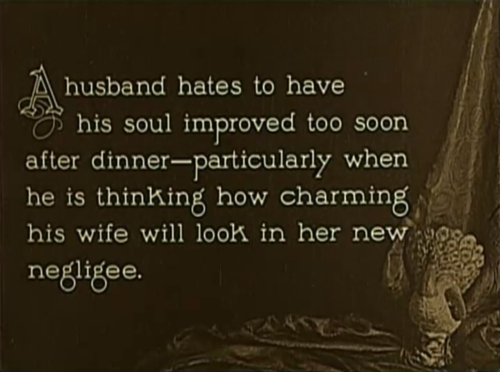
Why Change your Wife? is a viable comedy: from Chaplinesque pratfalls to the classical, stage requirements of the theater. Why Change Your Wife? (1921 Famous Players-Lasky Corporation/Paramount Pictures Distribution), directed by Cecil B. DeMille and written by (in alphabetical order) Sada Cowan, William DeMille and Olga Printzlau, offers a glitzy, stocking-and-gartered, Old Hollywood-styled, silent-era film of the alpha relationship. Like a banshee from the turreted rooftops, this sex farce shrieks the foibles of men and women, husbands and wives, whilst whispering from those same turrets those of mother and child. Mother and son, to be more accurate; for, that is what lies at the foundation of this sociological flicker. Shakespearean in its storyline, Freudian in its subtext, this follow-up to DeMille's 1919 Don't Change Your Husband posits, and eventually answers, an common, albeit underlying and queasy quandary ... Do men want to marry their mothers? Though most prefer to build a Home Depot over all that and let it remain buried, there are as many responses to said-quandary as there are men, and mothers.
Synopsis: Robert and Beth Gordon (Thomas Meighan and Gloria Swanson) are married. Period. He heads to work, she stays home. He tries to shave each morning, she hogs the mirror. He likes fox trots, she prefers classical. He loves his dog, she sees walking disease. He likes to dance, she likes to read. He buys her lingerie, she finds it disgusting.
In a moment of concession, Beth tries on the new negligee, just hours earlier modeled in-store by a young nymph named Sally. Beth, unsure of how to rock such gear and Robert, clueless as to how to help her rock it, tries his best. Do you know, somehow in the shop, it looked - thinner. Brilliant, Bob. Brilliant. Still a sport, she tries to get in the mood with the same face and enthusiasm one gives while cleaning hair from a shower drain. Quelle surprise, she just can't do it. You expect me to share your Oriental ideas? Do you want your wife to lure you like a - a - Oh, why didn't you marry a Turk?
Robert should have known better. All of her puritanical tendencies are clearly evident; she wears thick glasses and her hair rolled up. Duh. Beth finds most every habit of Robert's vile: smoking, eating, drinking, dancing, lusting. At every turn she not only lets him know of her disapproval, but she takes the opportunity to educate him and change his boyish charms, certainly the dangerous charms which lured her to him originally. Robert, why will you play that awful, physical music? Try to cultivate your taste, dear! Enter sexy, jazzy Sally.
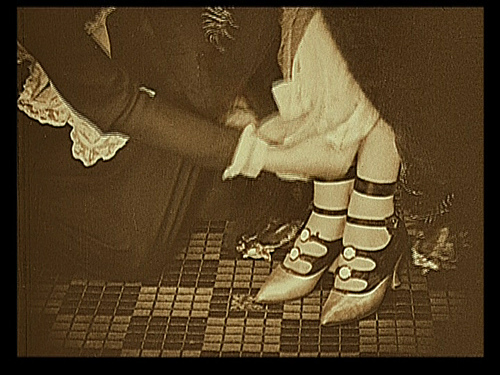
He likes Sally, Sally likes lingerie and knows exactly how to rock it. Sally likes smoking, jazz, dancing, parties, stockings, feathers, rhinestones, shoes with kitten heels and best of all booze! The outlook is clear and a million, as pilots say. Bob skeezes about with Sally, Beth smells Sally's lurid Persian Nights perfume on Bob one night, Beth files for divorce. Bob is okay with that and quickly weds Sally. Even the dog is happy, for a bit.
The day the divorce is final, Beth's Aunt Kate takes her shopping. Surely a new frock will heal her pain. In a scene right out of Cougartown and with mere curtains for dressing room partitions, the jazzy gals next door overhear Beth's woes, and she their analysis of said-woes. Feeling pity for her, they also conclude she may have brought it on herself, judging she just wouldn't play with her husband and dresses like his aunt, rather than his wife. A sting makes a mark and she realizes perhaps she has become a bit mumsy and let herself go. Nothing like than loosening the hair, losing the glasses and shimmying into some embroidered stockings and a backless, sleeveless, transparent and indecent number to let the world know how Beth got her groove back.
Thank goodness for coincidence, for soon Robert gets a gander of Beth and her smashing, previously unseen gams at a swanky resort. Beth bought the very bathing suit the dressing room gal had tried on that fateful day, recalling the sage words of the shop clerk: If a girl can wear a bathing suit like this - it's her duty to do so! Pity Sally doesn't look as good this day. In fact, as Beth lounges poolside in her scandalous suit and is wooed by a dozen dapper dandelions, Sally has become a drag and a plain old nag. Taken to correcting Bob's posture and manners in public, she doesn't even love his dog anymore. She's hogging the mirror now and, funny enough, the new Mrs. Gordon appears shorter, dumpier and duller than the shiny new ex-Mrs. G. Naturally, Robert notices all of this. The liberated ex and the man-toddler Robert, tired of his new toy, fall in love all over again.
:End Synopsis
Sally frets briefly at the resort breakup. Happily for her though, she spies a yummy new target and cries the battle charge that would do a Real Housewife proud: Remember the Alimony! Beth, for her part, now loves Bob's dog, digs jazz, shows off her junk, pours out the gin, presumably puts out and, like a good girl, probably hates books. She snaps in two her favourite, classical record and to the delight of all, she finally dons that Oriental negligee Robert bought her, pre-divorce, and they merrily direct the maid and valet to not only bring Beth's bed in from the other room, but, hold on to your bippies Rob and Laura Petrie, push those matrimonial beds together.
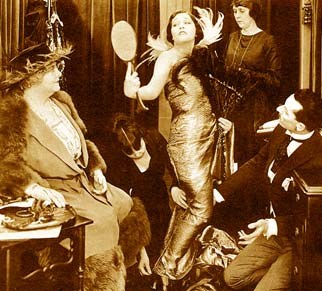
You may ask, where is the contemporary link here? How is this adaptable and humorous to vous? It's funny alright and it's relative. Just as Shakespeare's sex comedies are apropos today, so go the marriage farces of the silent era and the career girl-loves-slacker dude, Judd Apatow films of today. Plain old human nature; only the negligees and the music have changed. There's a lesson for everyone involved; there's also a realization for many. Some men need a mom for a wife and some men don't. Simple. If your goal is to dust them off and dress them up in a sailor outfit, they'll let you know pretty quickly if that's okay. If they already have a mom and want a wife, they'll let you know that, too. Some men need that structure and guidance; they'd be a train wreck without it. Others direct themselves nicely and need a partner to co-pilot with them. Of course, some want a co-pilot who'll simultaneously spoon-feed and navigate while they fly. Those are probably trickiest for the wife. The others are pretty cut-and-dry. I think the Mr. Gordons of the world may need the rare, gin-swilling mom in a sleeveless, backless, transparent, indecent number.
In the end, women, for it does appear men of the '20s had little to learn, are proffered advice that might be heeded by both husbands and wives. My proffering? Men, make your intentions clear; women, don't change your husband. Live by it, laugh at it or rail against it, it suits all well on some level.
"And now you know what every husband knows: that a man would rather have his wife for his sweetheart than any other woman: but Ladies: if you would be your husband's sweetheart, you simply must learn when to forget that you're his wife."
-Why Change Your Wife? - final intertitle
*************************************************************************************************************************
Wondering who the heck Cecil B. DeMille is? Did you read this and think, "I wasn't born in 1920" and therefore couldn't possibly know about people whom lived when everybody walked really fast in newsreels? (Pet peeve of mine, btw. You really can't know about anything or anyone whom existed before your birth year? I know about Mozart, John Dillinger and Edward the Confessor, but ... ) Anyhoo, if you're still bored at work, allow me to introduce you ...
Cecil B. DeMille, for those of you familiar enough with the name, yet unsure as to whether or not he's that dude in your algebraic topology class who always wears the Andy Capp hat and who constantly smells like weed, or if you think you've seen the name on the end credits of a Chuck episode, allow me to school you real quick.
Briefly, Mr. DeMille (professional spelling, as opposed to de Mille, which he used in his personal life), the son of a Columbia University professor and a girls' school headmistress, made seamless and timely transitions from theater and vaudeville in New York to the sunny climes and silent moving pictures of Hollywood and well into the era of the talkies, Technicolor and television. Earning a Best Picture Oscar in 1953 for The Greatest Show on Earth would be an achievement of note; yet, like Thomas Jefferson, who chose to omit "U.S. President" from his epitaph, Cecil Blount DeMille had more than enough to adorn his symbolic epitaph. Founding partner of Paramount Pictures, founder of the Academy of Motion Picture Arts and Sciences, member of the first Board of Directors for Bank of Italy (later to become Bank of America) and founder of Mercury Aviation, the first commercial airline to offer passenger service on a regular schedule, were all virtually accomplished before Yours Truly changed out of her jim-jams this morning.
Above all, DeMille was of that great hybrid: filmmakers, storytellers, auteurs, visionaries and businessmen. Like Shakespeare, Spielberg, Lucas, Edison (Thomas Edison, being one of the industry's first filmmakers: late-19thC.), Allen and Disney, DeMille knew how to tell a story, show a story, produce a story, monetize a story. In the glorious, if not always ethical, early days of Hollywood and its studio system, all but six of his seventy films turned a profit. Known for Biblical, historical and grand-scale productions, he cemented mainstays like Cleopatra, The Ten Commandments, Samson and Delilah, Reap the Wild Wind and The Warrens of Virginia firmly into the groundwork of west coast filmmaking. Unafraid of success and blissfully unashamed of his achievements (a characteristic curiously and frighteningly frowned-upon in this New World Order of 2011), DeMille, like so many a successful titan of any industry, understood the need to evolve and pioneer ahead into frontier territory. Imagine what he might have done in the era of Bill Gates, Google and Netflix.
She's so evil and she's only in high school.
-Jawbreaker
{youtube width="580" height="380"}PZ19fV8BiKM{/youtube}
Spot-on. Shunned by many as "teen-oriented" or even, the horror, "chick-flicks" (which I basically loathe) the much misunderstood and wrongly maligned film genre, covered snuggly under the umbrella of Dark Comedy, is a chick-flick of some sort, but not the whiny, "when will I find a man I love as much as my Pradas" type of crap. No, this genre is the Evil High School Chicks. . .flicks. These flicks are far deeper and certainly more wicked than your average teenage, high school romp. These are not the likes of High School Musical, Grease (which was pretty silly when you consider all the 'students' were about forty), The Babysitters Club (junior high, I know), or even the darker, Italian Vogue-esque, modern version of 90210 (God, I miss Dylan, speaking of forty-year-old high schoolers.) No, the EHSC are a class all unto themselves. Were they an exhibit at the San Diego Zoo, they would have to be on-loan to China, where they would, without a doubt, be a huge hit, for at least two years whilst San Diego built and outfitted a completely new enclosure for them. They would not adapt at all to the other primates; plus they would need more mirrors than the orangutan habitat.

